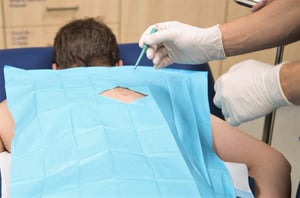Skin cancer biopsy: everything you need to know
If your doctor finds a suspicious spot during your regular skin check, they may need to take a biopsy. That sounds a lot scarier than it actually is, so we have answered some common questions about skin cancer biopsies to put your mind at ease.
Why do I need a skin biopsy?
If your doctor finds a suspicious spot that shows signs of being skin cancer, they might need to perform a biopsy to confirm whether it is cancerous and, if so, what kind of cancer it is. The type of cancer will influence the treatment you receive. For example, a skin cancer like melanoma will require a more aggressive treatment than a less-threatening skin cancer such as basal cell carcinoma. So, your doctor will take a biopsy to confirm whether you have skin cancer and what specific type it is so that they can plan the appropriate treatment for you.
 What does a skin biopsy involve?
What does a skin biopsy involve?
A biopsy involves taking a small sample of skin to be analysed by a pathologist at a laboratory. The pathologist who examines the sample is specially trained in diagnosing skin conditions including skin cancers. They will help to confirm your doctor's diagnosis, the depth of the cancer, and the extent to which it has spread. This information all influences the kind of treatment you will receive.
How is a skin biopsy taken?
There are three ways a biopsy can be performed.
1. For a punch biopsy, the doctor uses a small tool to extract a tube-shaped sample of skin and some underlying tissue.
2. A shave biopsy involves using a tool to scrape a small sample of tissue from the surface of the skin.
3. An excision biopsy refers to the complete removal of the suspicious spot and a margin of surrounding tissue, usually through the use of a scalpel blade.
Biopsies take just a few minutes and will sometimes require a stitch and dressing. Your aftercare nurse will explain how best to care for your wound after the procedure.
How do I get the biopsy results?
It may take several days for the results of the biopsy to be received. Your doctor will schedule a follow-up appointment so that you can discuss the results together. It is very important that you attend this appointment. Your doctor will discuss the results and the treatment options with you at length. In most cases, when found early, skin cancer can be easily and successfully treated with surgery. Most skin cancers are cured once they are removed. Other non-surgical treatments may be used but this will depend on the type of skin cancer found.
Why can't the doctor perform the treatment on the day of my skin check, without a biopsy?
You may feel impatient to have suspicious spots treated as soon as possible. Waiting for biopsy results can be frustrating and it is normal to want a potential skin cancer removed at your initial skin check instead of scheduling a second appointment. However, it is crucial for your doctor to know what kind of skin cancer they are treating before they perform any procedures. You might have a more serious skin cancer that requires aggressive treatment, or your suspicious spot may be completely benign.
Will the doctor take a biopsy of all my suspicious spots?
Your doctor will typically only biopsy spots that they highly suspect to be cancerous. Our doctors are specially trained to identify characteristics indicative of skin cancer and, if they are unsure about a spot, there are other ways of identifying whether it is cancerous. Your doctor may choose to monitor suspicious spots over a period of time to check for any changes (which may be a sign of skin cancer) rather than taking a biopsy, especially if you have a lot of moles.
- Tags:
- Treatment
